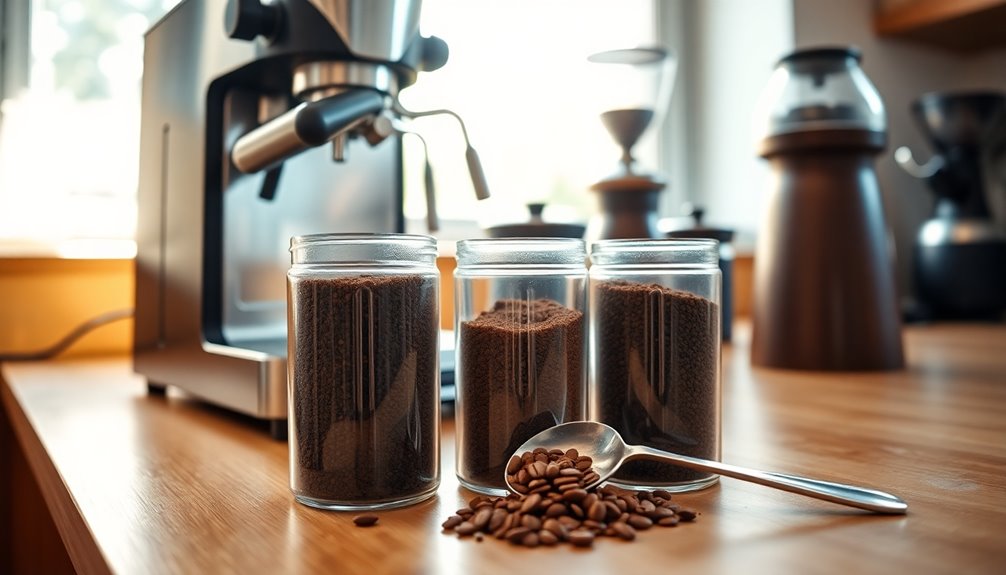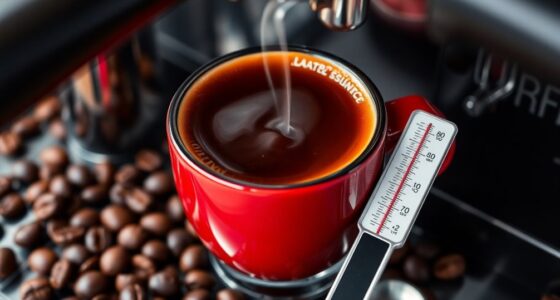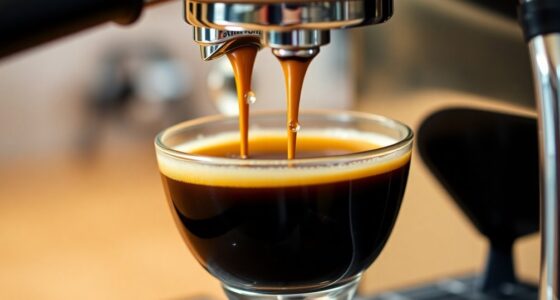To choose the right coffee grind for your espresso machine, aim for an extra fine consistency, similar to powdered sugar. This grind maximizes extraction during the quick brewing process of 25-30 seconds. A burr grinder is your best option for consistent size. Remember, the grind can be adjusted if your espresso tastes sour (too coarse) or bitter (too fine). Understanding these elements will enhance your espresso experience, and there’s more to discover about perfecting your brew.
Key Takeaways
- Use an extra fine grind, similar to powdered sugar, for optimal espresso extraction during a 25-30 second brew time.
- Choose a burr grinder for consistent grind size and adjust the fineness based on the coffee type and desired flavor profile.
- Regularly recalibrate your grinder with each new coffee bag to maintain consistent grind size and avoid under- or over-extraction.
- Store ground coffee in airtight, opaque containers in cool, dark places to preserve freshness and flavor.
- Experiment with grind size adjustments based on taste; sour espresso may need a finer grind while bitter espresso may require a coarser grind.
Understanding the Importance of Grind Size for Espresso
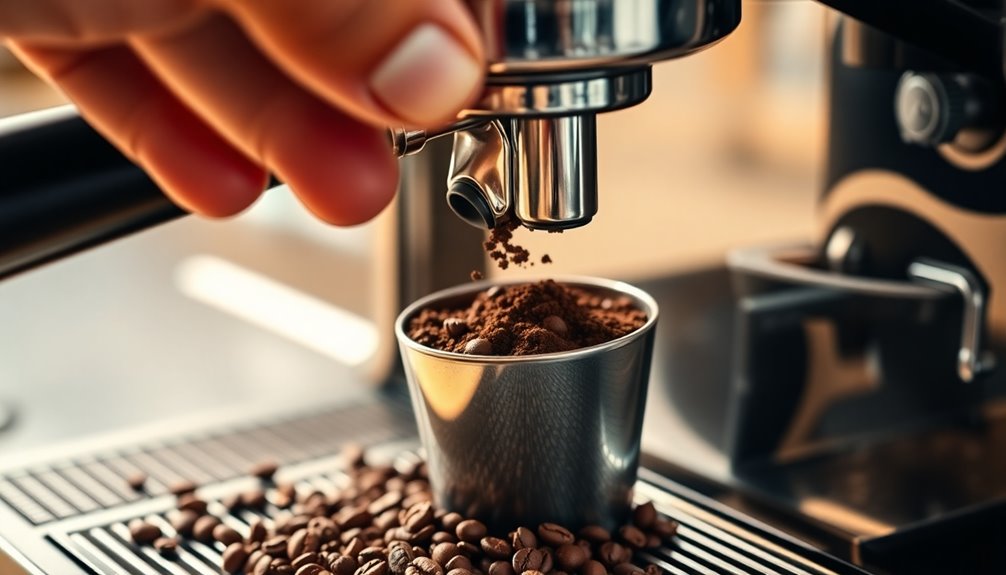
When it comes to brewing the perfect espresso, grind size plays a pivotal role. The ideal grind size for espresso is extra fine, similar to powdered sugar, which maximizes the extraction process within the quick brewing time of 25-30 seconds.
A finer grind increases the surface area of coffee grounds, allowing water to dissolve flavor compounds effectively. Consistency in grind size is essential; even minor variations can lead to under-extraction, resulting in weak and sour espresso, or over-extraction, creating harsh and bitter flavors. Understanding the mechanics of French press coffee can also provide insights into achieving the perfect grind size for your espresso machine.
The Mechanics of Espresso Machines
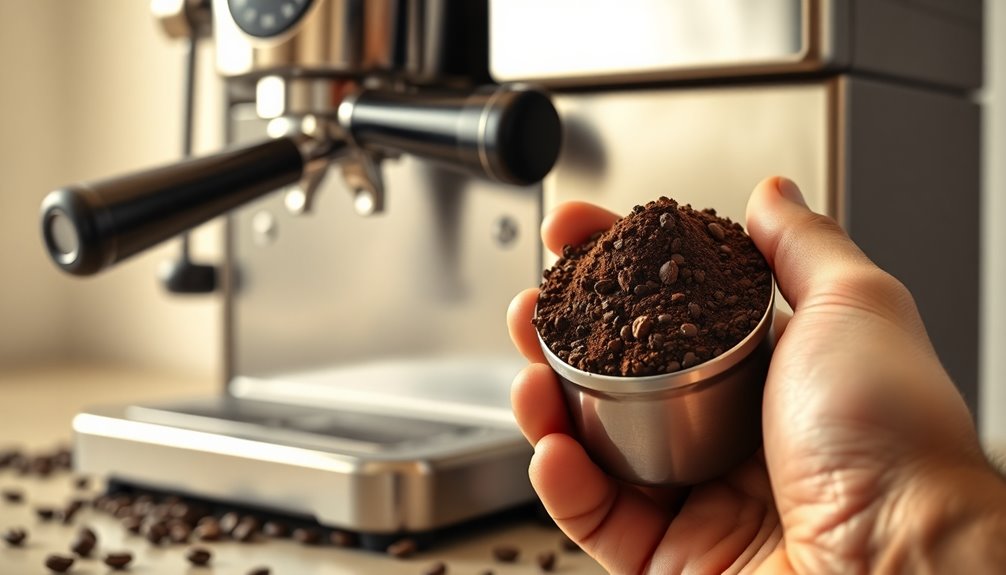
Understanding how espresso machines work is fundamental for crafting the perfect shot. These machines use high pressure, typically 9 to 15 bars, to push hot water through finely ground coffee, resulting in concentrated shots in just 25-30 seconds.
| Factor | Importance |
|---|---|
| Grind Size | Affects water flow and extraction |
| Tamping Pressure | Guarantees even coffee bed density |
| Temperature Control | Essential for flavor balance |
| Water Distribution | Impacts consistency of extraction |
| Best Extraction | Achieves the best flavor profile |
For best flavor extraction, you need a consistent grind size to avoid channeling. Remember, the interplay between grind size, tamping pressure, and temperature control is critical for a balanced espresso experience. Additionally, understanding the caffeine content in espresso can help you tailor your coffee experience to your personal preferences.
Recommended Grind Sizes for Different Coffee Types
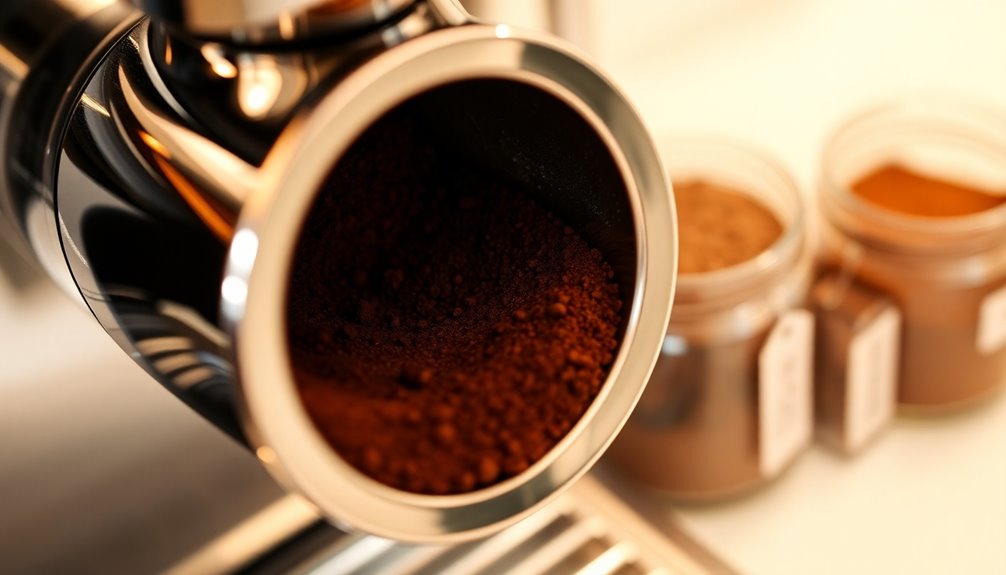
When you’re brewing coffee, the grind size plays an essential role in flavor extraction.
For espresso, you need a fine grind, but other brewing methods require different textures for ideal results.
Let’s explore how grind sizes compare across various coffee types and their impact on taste. Additionally, the average ice cream consumption in the U.S. illustrates how preferences for various flavors can influence overall beverage choices.
Espresso Grind Size Essentials
Choosing the right grind size is essential for brewing a perfect espresso, and it all starts with a fine grind, similar to powdered sugar. This fine grind for espresso maximizes the surface area, ensuring ideal extraction of flavor and aroma during the quick 25-30 second brewing process.
To achieve consistent results, keep these tips in mind:
- Always use a fine grind for espresso beans.
- Adjust your grinder carefully; small changes can lead to over-extraction or under-extraction.
- Monitor your brewing conditions to maintain balance in flavor.
Additionally, incorporating ingredients like chia seeds can enhance your overall health, contributing to better digestion and satiety, which may complement your coffee experience.
With the right espresso grind size, you’ll elevate your coffee experience and enjoy the rich, bold flavors that only a well-crafted espresso can provide.
Comparison With Other Brews
While espresso demands a fine grind for ideal extraction, other brewing methods require different grind sizes to achieve their unique flavor profiles. Here’s a quick comparison of recommended grind sizes for various coffee brewing methods:
| Coffee Type | Grind Size |
|---|---|
| Espresso | Fine (powdered sugar) |
| Drip Coffee | Medium (beach sand) |
| French Press Coffee | Medium Coarse (raw sugar) |
| Cold Brew | Coarse (coarse salt) |
Using the right coffee grind size is essential for each method. For instance, cold brew needs a coarser grind to prevent over-extraction during its long steeping. Investing in a quality burr grinder helps achieve the perfect espresso and enhances your coffee experience across all brewing methods. Additionally, the choice of grind can also influence cognitive function due to the varying brewing times and extraction processes.
Impact on Flavor Extraction
Understanding how grind size impacts flavor extraction is vital for crafting the perfect cup of coffee. For espresso, you need a fine grind, similar to powdered sugar, allowing ideal flavor extraction within 25-30 seconds.
Choosing the wrong grind can lead to undesirable results:
- Coarse grind: Causes under-extraction, resulting in weak and sour flavors.
- Overly fine grind: Leads to over-extraction, creating bitter and harsh tastes.
- Medium grind: Best for drip coffee, balancing flavor and aroma.
Adjusting grind size is important; even minor tweaks can greatly affect the flavor profile. Additionally, the concept of nutrient density highlights how the right coffee grind can enhance the overall quality of your beverage, similar to how whole fruits provide greater health benefits compared to juices.
The Relationship Between Grind Size and Flavor
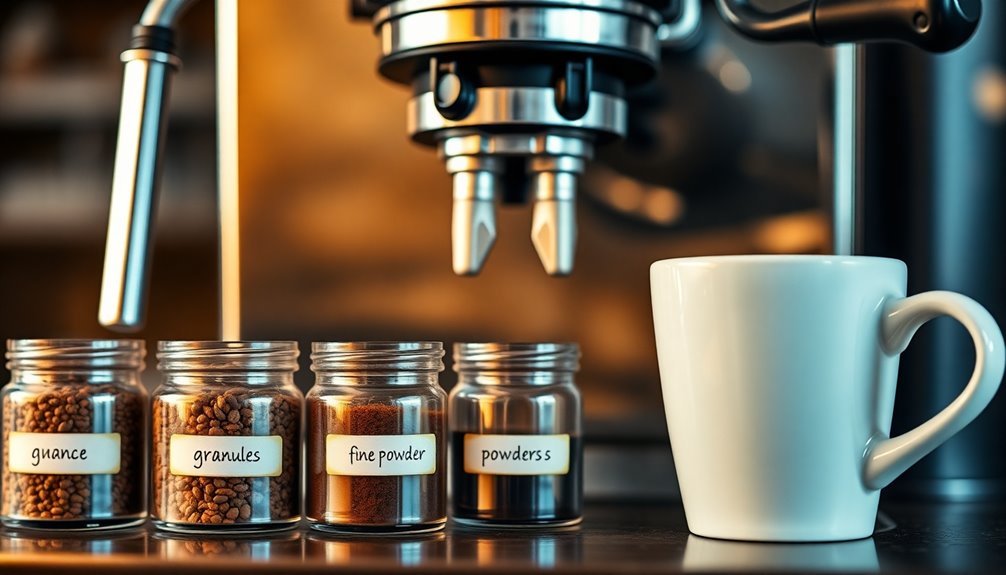
The grind size of your coffee can dramatically influence the flavor of your espresso, as it directly affects extraction during brewing. For ideal results, aim for a fine grind that resembles powdered sugar. This increases the surface area, allowing for faster extraction of flavors and oils essential for a rich, balanced shot.
If your grind is too coarse, you risk under-extraction, leading to sour and weak flavors. Conversely, a grind that’s too fine can cause over-extraction, resulting in bitter and harsh tastes.
Consistency in grind size is essential; varying particle sizes can disrupt uniform extraction and negatively impact your espresso’s overall taste. Small adjustments can transform your brew from under-extracted to perfectly balanced. Additionally, investing in a quality grinder can significantly enhance your coffee brewing experience, ensuring that you achieve the perfect grind every time.
Selecting the Right Coffee Beans for Espresso
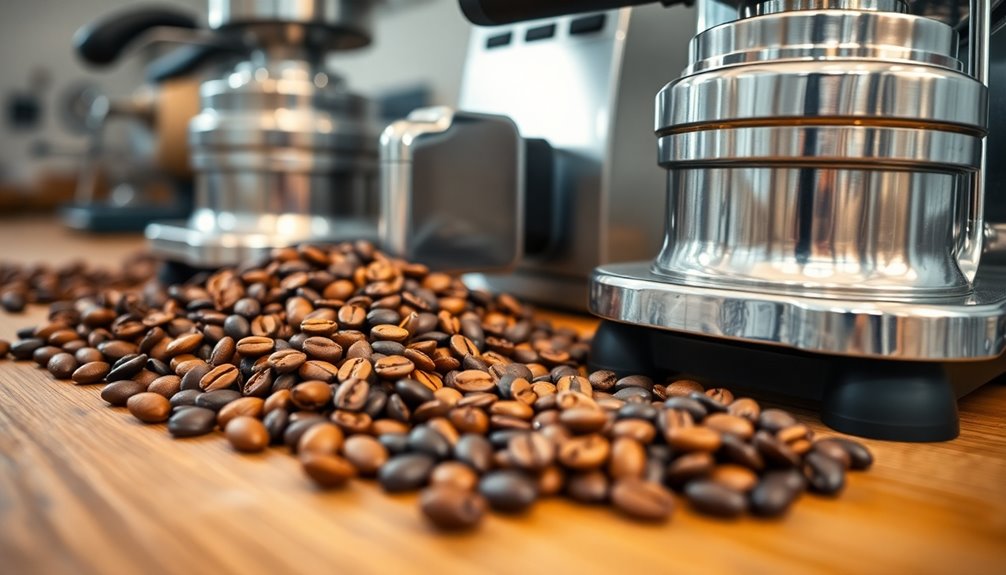
A great espresso starts with the right coffee beans, which play a pivotal role in determining the final flavor profile.
To brew the perfect espresso, consider these key factors:
- Blend of Beans: A mix of Arabica and Robusta often delivers richness and low acidity.
- Freshness: Aim to use your coffee beans within 5-30 days of their roast date for peak flavor and aroma.
- High-Quality Beans: Premium beans greatly impact the taste, body, and acidity of your espresso.
When selecting your coffee beans, pay attention to their origin, as Latin American beans are typically mild and fruity while African beans can be bright and floral.
Additionally, investment in quality beans is crucial, as it can enhance your overall espresso experience and bring out unique flavor notes.
Choosing the right beans is essential to achieve that exceptional espresso experience.
Choosing the Best Grinder for Espresso
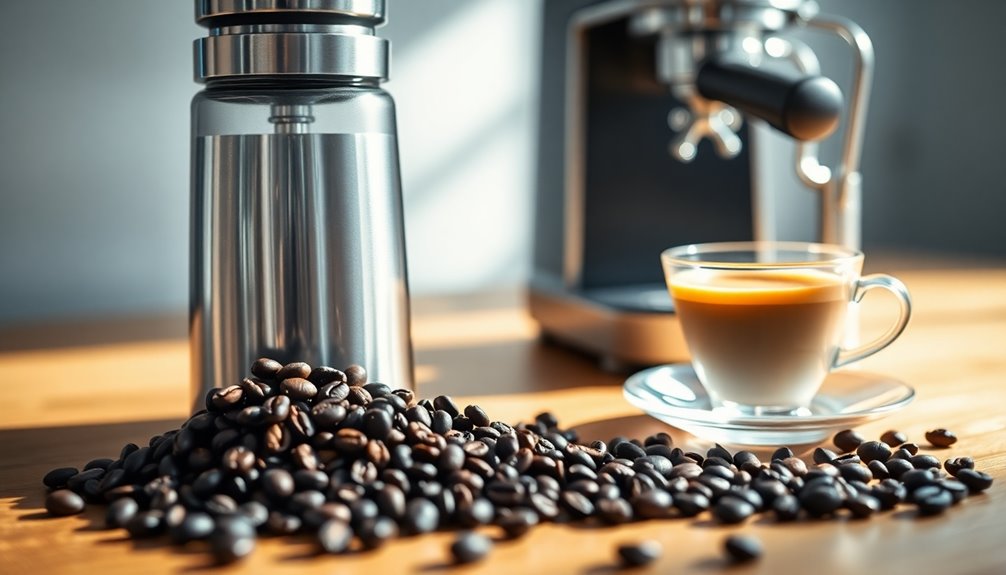
How can you guarantee your espresso grind is just right? Start by choosing a high-quality grinder, preferably a conical burr grinder. This type guarantees a consistent grind size, which is vital for ideal extraction of your espresso beans.
Look for grinders with at least 40 grind settings; this gives you the flexibility to adjust for different beans and your taste preferences. A model like the Baratza Virtuoso+ strikes a great balance between price and performance. It also features precision control with a digital timer, allowing you to maintain consistent grind amounts. Additionally, investing in a grinder with precision control ensures that you achieve the optimal grind size for your espresso.
Finally, don’t forget regular maintenance—cleaning the burrs helps preserve flavor and prevents stale tastes in your espresso.
Tips for Grinding Coffee Beans at Home
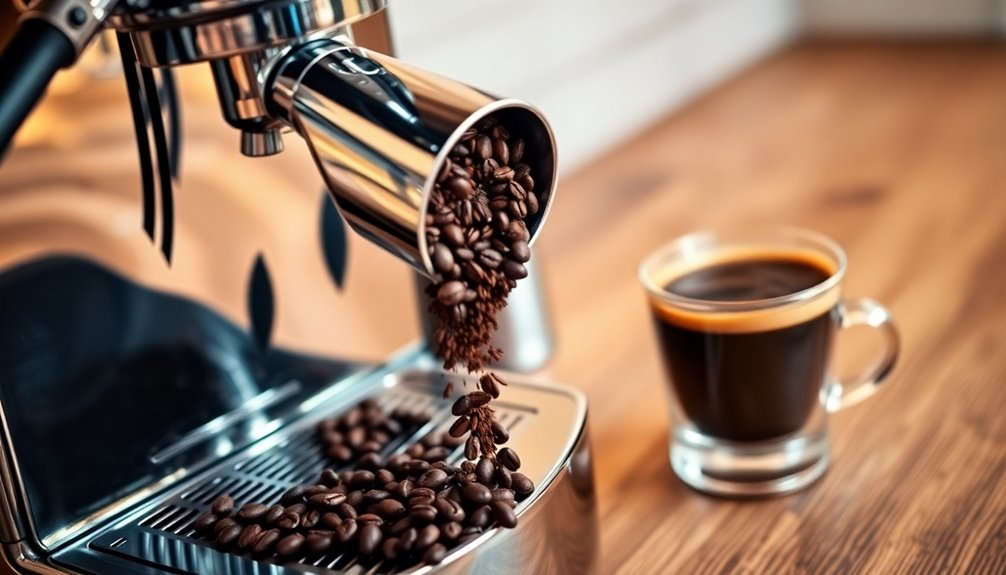
When you’re grinding coffee beans at home, picking the right grinder is essential for a great espresso. You’ll want to make adjustments to the grind size based on the beans you’re using to get the best flavor. It’s important to consider that coffee consumption can vary significantly across different cultures, influencing the preferences for grind size and preparation methods. Let’s explore how to fine-tune your grinding process for ideal results.
Selecting the Right Grinder
Choosing the right grinder is vital for achieving the perfect espresso, especially since the grind size greatly impacts flavor and extraction. Here are some key features to evaluate for your coffee grinder:
- Burr Grinders: Opt for burr grinders over blade grinders for consistent grind size, which is important for ideal extraction.
- Grind Settings: Look for grinders with at least 40 degrees of fineness adjustment to fine-tune your grind size based on the beans.
- Digital Timer: A digital timer helps you control grind time precisely, ensuring consistency in every brew.
Don’t forget to regularly clean and maintain your grinder to avoid coffee residue build-up, which can affect taste and grind consistency.
With these tips, you’ll be on your way to brewing exceptional espresso!
Grind Size Adjustments
While dialing in your espresso, adjusting the grind size is essential for achieving the perfect shot. A fine grind size, resembling powdered sugar, increases surface area and speeds up extraction under high pressure.
Use a burr grinder, preferably conical, to guarantee consistent grind sizes that deliver a balanced flavor and prevent under- or over-extraction.
If your espresso shots taste sour, consider a finer grind to slow down extraction time. Conversely, if your espresso is too bitter, switch to a coarser grind to speed it up.
Always recalibrate your grinder with each new bag of coffee beans, as different beans may require subtle grind size adjustments for peak flavor extraction.
Storing Ground Coffee for Maximum Freshness
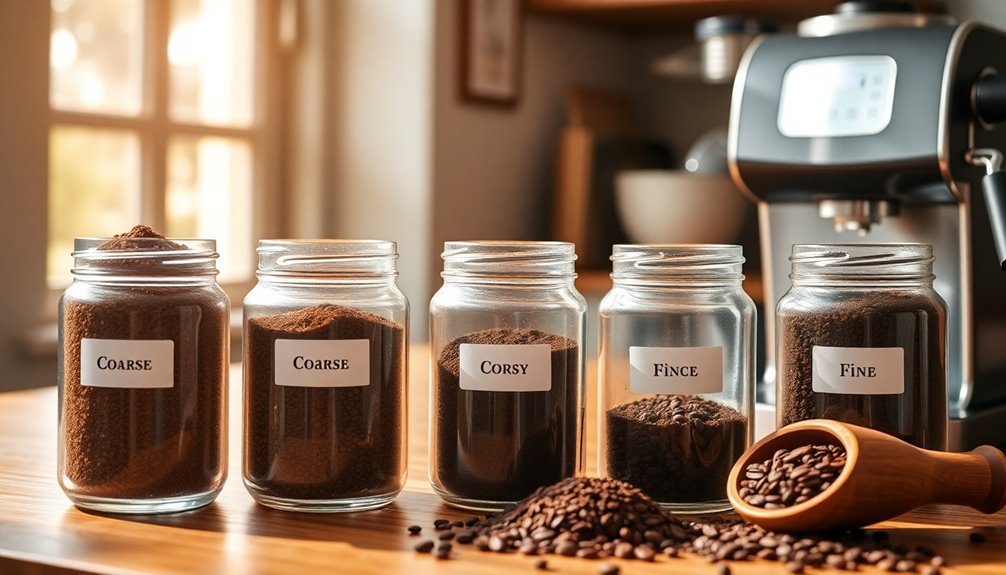
How can you guarantee your ground coffee stays fresh for that perfect espresso? Proper storage is key to maintaining its flavor and freshness. Here are some tips to enhance your coffee storage:
- Use an airtight container: This minimizes oxidation and keeps your ground coffee flavorful.
- Choose an opaque container: Blocking light prevents UV rays from degrading aroma and freshness.
- Store in a cool, dark place: Avoid heat sources to protect against moisture and heat damage.
For peak freshness, consume your ground coffee within a few weeks of grinding.
If you want to extend its shelf life, consider vacuum-sealing your grounds. This reduces oxidation, preserving both flavor and aroma for a longer time.
Exploring Specialty Coffee Options for Espresso
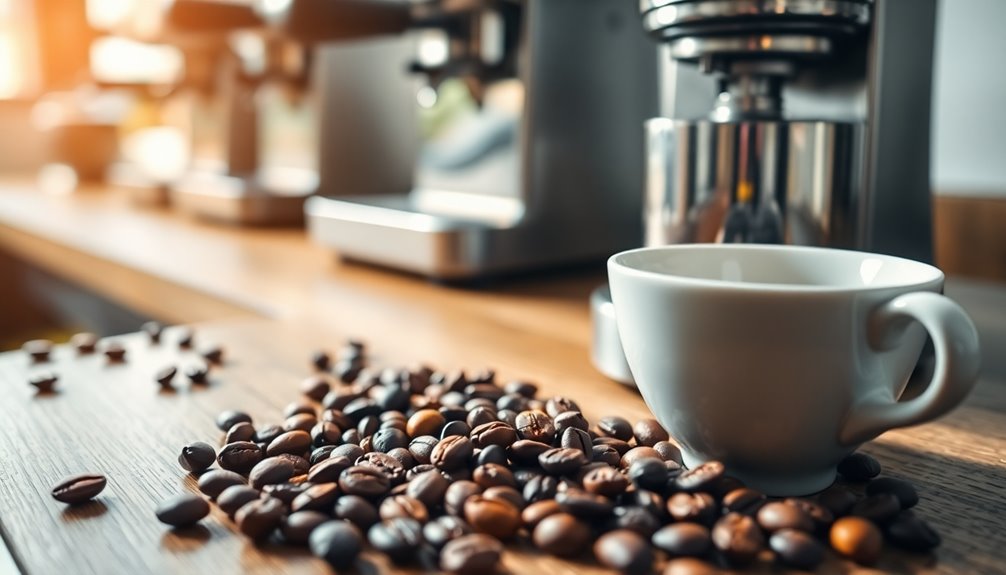
When you plunge into the world of specialty coffee for espresso, you’ll discover a rich tapestry of flavors waiting to be explored. Options like Old Mother Nightshade from Peru and King Canute from Ethiopia each boast unique flavor profiles.
The Lincoln Imp blend, combining beans from Ethiopia, Peru, and Nicaragua, offers a well-rounded taste that coffee enthusiasts adore. Don’t overlook Nanny Rutt from Brazil, which delivers a rich and smooth experience.
Many specialty coffee roasters provide beans ground specifically for espresso, ensuring ideal extraction and flavor. Experimenting with alternative brewing methods, like Aeropress or V60, can further enhance your appreciation of these specialty coffees, showcasing their distinct characteristics and rich flavors, making every cup an adventure.
Frequently Asked Questions
What Grind Is Best for an Espresso Machine?
The best grind for an espresso machine is fine, like powdered sugar. This size maximizes flavor extraction during the quick brewing process.
You’ll want to use a conical burr grinder for consistent results, as it guarantees uniform particle sizes.
Keep in mind that you might need to adjust the grind based on your coffee bean type. Aim for about 18-20 grams of coffee for a double shot, grinding just before brewing for the freshest flavor.
What Is the Best Ground Coffee for an Espresso Machine?
The best ground coffee for your espresso machine is an extra fine grind, similar to powdered sugar. This grind allows for ideal extraction during brewing.
Freshly roasted beans, used within 5-30 days of roasting, deliver the best flavor. Aim for medium to dark roasts for richness and lower acidity.
Typically, you’ll need 18-20 grams of coffee, and a quality burr grinder guarantees consistency, enhancing the overall quality of your espresso shot.
What Grind of Coffee Is Used in Espresso Coffee?
For espresso, you’ll need a fine coffee grind, similar to powdered sugar. This grind size allows for ideal extraction in the quick brewing process, usually taking 25-30 seconds.
Aim for a consistent texture, as uneven particles can lead to poor taste—either too bitter or too weak. Generally, using about 20 grams of finely ground coffee will give you a balanced flavor in your double shot.
Adjust based on your beans and machine for the best results.
What Blend of Coffee Is Best for Espresso?
When it comes to the best blend for espresso, you’ll want to look for a combination of Arabica and Robusta beans.
Arabica brings sweetness and complexity, while Robusta adds body and crema. Dark roasts are often favored for their rich flavor and lower acidity.
Don’t forget to take into account single-origin options from places like Ethiopia or Colombia for unique tastes.
Freshness is key, so aim to use beans roasted within 5-30 days.
Conclusion
Choosing the right coffee grind for your espresso machine can seem intimidating, but it doesn’t have to be. While you might worry that fine-tuning grind size is too complicated, remember that practice makes perfect. By experimenting with different grind sizes and beans, you’ll discover the flavors you love. So, plunge in and have fun with it! With the right grind, you’ll elevate your espresso experience and impress everyone with your brewing skills.
